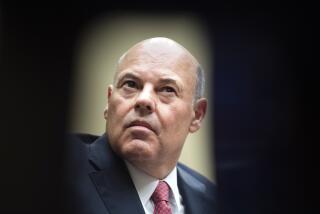Column: How ‘price-cutting’ middlemen are making crucial drugs vastly more expensive

Diabetes doctor Irl B. Hirsch has watched with dismay as more of his Seattle-area patients take life-threatening steps to deal with the soaring price of insulin.
Some need two vials a week of the crucial medicine, at $300 per vial. Many pay full price because they’re uninsured or enrolled in health plans with high deductibles. So they’re cutting back. “It’s becoming very, very common to see patients intentionally withholding their insulin,” says Hirsch, an endocrinologist and professor of medicine at the University of Washington.
He also knows where a good share of the blame lies: on pharmacy benefit management firms. “They’re middlemen we thought originally would make the distribution of medications easier, and more efficient, and even cheaper.” he says. “But now they want a cut of the money, and over the decades, they’ve wanted more.”
The PBMs are sitting at the center of a big black box. They’re the only ones who have knowledge of all the moving pieces.
— Linda Cahn, pharmacy consultant
Complaints about PBMs driving up drug prices have become increasingly common. A lawsuit filed May 23 in Los Angeles federal court, for example, alleges that Irvine-based PBM OptumRx and drug company Novo Nordisk joined in an “illegal pricing scheme” in which the drugmaker inflated the price of Victoza, a diabetes drug, to pay for “illegal kickbacks” to Optum. From 2009 through 2016, the lawsuit asserts, the average wholesale price per package of Victoza rose from less than $450 to $897.16 for roughly a one-month supply. The lawsuit seeks class certification to cover Victoza users who paid for the drug at least partially out-of-pocket.
Novo Nordisk said through a spokesman, “We’re aware of the complaint and disagree with the allegations.” OptumRx called the allegations “without merit. Both companies said they would defend themselves “vigorously.”
The three PBMs that dominate the field collect more than $200 billion a year to manage prescription services for insurance carriers covering 180 million Americans and government programs serving about 110 million more. The companies are publicly-traded Express Scripts; OptumRx, a subsidiary of the insurer UnitedHealth Group; and CVS Caremark, a subsidiary of the CVS drugstore chain.
The expansions of the PBMs’ role and income illustrate the opportunities for profiteering in America’s fragmented healthcare system. PBMs originated as intermediaries to help health plans process claims, steer doctors and hospitals to the cheapest drug alternatives, and allow insurers to combine their customer bases for greater leverage in negotiations with drug manufacturers.
But over time they became just another special interest. In the 1990s, some of the biggest PBMs were acquired by drug companies, creating conflicts of interest that led to federal orders for divestment. The next phase was a wave of mergers and acquisitions within the field, followed by acquisitions by insurers and pharmacy companies — CVS acquired Caremark, then the biggest PBM, in 2007 and UnitedHealth merged CatamaranRx, then the fourth-largest PBM, into OptumRx in 2015.
The position of the three major PBMs at the center of the drug distribution system appears to be unassailable for now. Last year CalPERS, California’s public employee benefits system, awarded OptumRx a five-year, $4.9-billion contract to manage prescriptions for nearly 500,000 members and their families enrolled in non-HMO health plans. The only other finalists in the bidding were CVS Caremark and Express Scripts.
Express Scripts reported profit of $3.4 billion last year, up 34% from 2015, on $100.2 billion in revenue, down slightly from $101.8 billion in revenue the year before. OptumRx reported operating profit of $2.7 billion last year, up from $1.7 billion the year before. CVS doesn’t break out its PBM financials.
Today the firms extract billions of dollars in price concessions from drug companies eager to remain in their good graces. The drugmakers’ goal is to secure spots on the PBMs’ formularies, the rosters of approved drugs the PBMs maintain for their health plan clients. To do so, the drugmakers offer PBMs rebates for each prescription filled and agree to a dizzying list of other fees. The PBMs say that since most of those rebates and fees are passed on to health plans and subsequently to patients, they fulfill their promise to reduce drug costs all along the line.
But no one can be sure that’s really happening, because the size of the rebates and the degree to which they’re passed along is guarded by the PBMs as trade secrets. Each PBM contract for each health plan, moreover, is concealed from other health plans.
“The PBMs are sitting at the center of a big black box,” says Linda Cahn, a drug pricing consultant to health insurers. “They’re the only ones who have knowledge of all the moving pieces.” Among the murky areas are how much in rebates and other fees the PBMs collect from drug companies, and what share gets passed on to health plans.
Whatever the pass-through, critics say the rebate process forces up prices. “It’s not a secret anymore that the drug companies are just raising prices to pay for the rebates,” says Derek Loeser, a Seattle lawyer who filed the Los Angeles lawsuit and others around the country making similar allegations.
The PBMs dispute that. “Rebates do not raise drug prices; drug companies raise drug prices,” says Brian Henry, a spokesman for Express Scripts, repeating a common industry mantra. He says “every client contract is clear” about how much of the rebates the PBMs keep for themselves. “These clients are sophisticated buyers of services,” he says.
Experts say that overstates how much health plans really know about the rebates. The insurers generally don’t have the right to audit PBMs’ rebate collections and distribution, says Susan Hayes, another insurance industry consultant. “The PBMs will say the rebate contracts are between them and the pharmaceutical companies, and it’s none of our business,” she says.
PBMs claim to save American consumers an average of $941 per year each by applying “sophisticated tools and strategies” to secure rebates and discounts and encourage the use of generic drugs. That’s according to the Pharmaceutical Care Management Assn., their trade group. Drug companies, health plans and retail pharmacies, however, all blame PBMs for the run-up in drug prices, albeit sometimes to deflect criticism about their own role in the system.
Last September, Heather Bresch, the CEO of Mylan, took this approach against attacks on her company for the sharp run-up in the price of the EpiPen, a dose of anti-allergy medicine used in emergencies. Of the $608 list price Mylan charged for a two-pack of EpiPens, she told a House committee, $334 went to middlemen. Industry experts say most of that money was pocketed by PBMs or at least passed through their hands. Bresch asserted Mylan had little choice but to jack up the EpiPen list price to accommodate the middlemen’s demands for rebates and fees.
PBMs and their clients even have begun squabbling over their shares of a piece that amounts to about $320 billion annually, or 10% of the overall U.S. healthcare bill of $3.2 trillion a year — the fastest-growing spending category.
In a lawsuit filed last year, Anthem, the nation’s second-largest health insurer, charged that Express Scripts extracted “an obscene profit windfall” of about $3 billion a year by failing to pass on all the savings it squeezed from drug companies in Anthem’s name. Anthem is thought likely to move to another PBM after the contract expires in 2019 or even to bring pharmacy services in-house. Express Scripts has said in response that it’s in full compliance with the contract.
Evidence that PBMs consistently protect insurance companies and their members from price increases is scanty. A University of Chicago study published this year found that EpiPen patients’ out-of-pocket spending, including copayments and deductibles, more than doubled to an average $75.50 from 2007 through 2014, even though the number of prescriptions filled per patient barely budged. Per-patient spending by insurers, meanwhile, more than quadrupled to $393. The “main driver” of the increased costs to consumers, the researchers found, was “the aggressive pricing by Mylan.”
There are some signs that the PBMs have become so greedy that they’ve opened the door for a new breed of rival.
“It’s very feasible for an entity like Amazon or Wal-Mart to create a different kind of PBM,” says Cahn, “a competitive marketplace that will force manufacturers to reduce their prices.”
That may already be happening. Amazon is reportedly pondering an entry into the pharmacy business. And as insulin prices have soared, Wal-Mart began selling varieties of the medicine — NPH and regular insulin, which are short- and intermediate-acting — for as little as $25 a vial.
Those drugs aren’t the right choice for all patients, says Hirsch of the University of Washington. But he’s heartened by signs that other drug distributors are falling into line, including CVS, which is matching Wal-Mart’s price. Patients have to be educated about the lifestyle changes needed to take those forms of insulin and doctors how to prescribe them, Hirsch says. “But the good of it is that we may get insulin for everybody at a cheaper price.”
Keep up to date with Michael Hiltzik. Follow @hiltzikm on Twitter, see his Facebook page, or email michael.hiltzik@latimes.com.
Return to Michael Hiltzik’s blog.
More to Read
Inside the business of entertainment
The Wide Shot brings you news, analysis and insights on everything from streaming wars to production — and what it all means for the future.
You may occasionally receive promotional content from the Los Angeles Times.











